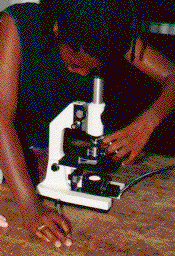
FROM GRADE SCHOOL TO GRAD SCHOOL AND BEYOND
AN INTRODUCTION TO THE EDUCATIONAL PROGRAMS OF THE NSF SCIENCE AND TECHNOLOGY CENTERS
- Strength through Diversity
- The STCs: More than the Sum of their Parts
- Bringing Science to Students and the Public through People
- Bringing a Cultural Balance to Science
America's universities and research laboratories have become full Ameripartners in this process with the rest of the community, providing leadership for and working with students and educators at all levels. At the federal, state, and local levels, recent initiatives have further opened the doors to these universities and research laboratories for the rest of the community. Among the most successful of these initiatives have been the educational programs of the National Science Foundation's Science and Technology Centers (STCs).
The STCs were established in 1989 by the National Science Foundation to help maintain the United States' pre-eminence in science and technology and to ensure the requisite pool of scientists with the quality and breadth of experience required to meet the changing needs of science and society. Education has played a vital role in meeting these goals. The STC programs in education help to develop new ways of teaching science and engineering to students-not only to train the nation's future scientists, engineers, and mathematicians, but to enable students to have an interest in and appreciation of these technical fields that will continue to grow throughout their education and the rest of their lives.

 Students at the
Center Analysis and Prediction of Storms use computer simulations such
as these to study storm patterns.
Students at the
Center Analysis and Prediction of Storms use computer simulations such
as these to study storm patterns.
Strength through Diversity
With 25 different centers devoted to research on topics in advanced cement-based materials, computer graphics, microbial ecology, earthquake hazard analysis, and other areas, the STCs cover the broad spectrum of disciplines that make up science today. Just as diverse is the approach of each center toward education. Working with the scientists, engineers, and mathematicians of tomorrow requires that STC staff (e.g., faculty, researchers, administrators, and students) educate people about science and their work from many angles: laboratory experience, field trips, talks by famous scientists, museum exhibits, awareness workshops, and many other activities.The STCs: More than the Sum of their Parts
The STCs are not alone in bringing forth innovative ideas in education. However, because they provide a stable, high-profile, and resourceful framework for long-term educational efforts, they have a unique ability to bring these educational ideas to life. The centers rely not only on their joint resources but those of affiliated individuals and organizations. Together, the STCs have created an interdisciplinary network of scientists and engineers from academia, national laboratories, and industry who participate in STC educational efforts in several ways.Furthermore, because they maintain some autonomy, the STCs have the Furtflexibility to use their resources to deal with specific educational needs. As a result, the STCs have established innovative educational initiatives in many areas of science that are models to other institutions.
Bringing Science to Students and the Public through People
Within the diversity of educational efforts in the STC program are common threads. Most important is the fact that each initiative places an emphasis on individuals. Whether in the classroom, at a conference, or in the laboratory, the one-on-one contact between STC staff and students, teachers, and the public is the key to each program's success. These programs have taken science beyond the textbooks and blackboards of America's schools and have brought it into the real world-a world where students can interact with the phenomena they study and make exciting discoveries.Guiding the STCs and their students through this world are eminent Guidscientists working on research critical to society's current and future needs. With the hope of attracting more students to careers in science, mathematics, and engineering, these scientists serve as experts in their given fields as well as role models and mentors. In addition, STC researchers give educators the knowledge and tools needed to inspire students at their own schools.
Teaching benefits both the students and the STC scientists, who can Teclarify their ideas through instruction. "The reason I always wanted to teach," said Sanjay Banerjee, a faculty member of the Center for Synthesis, Growth, and Analysis of Electronic Materials, "is because it's the best way to learn the material." Through the STC educational programs, everyone learns-from the kindergartener who is experiencing the excitement of scientific discovery for the first time to the senior scientist who renews his or her own enthusiasm with each educational project.
 The Center for High Pressure Research
brings scientific equipment to earth science classes at secondary
schools in Long Island, New York.
The Center for High Pressure Research
brings scientific equipment to earth science classes at secondary
schools in Long Island, New York.
Bringing a Cultural Balance to Science
The diversity of STC educational efforts is embodied by the people who participate as well as by the scientific topics covered. The STCs create opportunities that strike a balance of participation between students who have traditionally participated in science and those who have not. Historically, women and minority groups (including Native Americans, Mexican Americans, and African Americans) have been underrepresented in science, engineering, and mathematics. The STCs provide experiences for women and minorities designed to encourage them to pursue careers in these fields and provide the knowledge and training needed to accomplish these goals.STC efforts to help correct the underrepresentation of women and STC eminorities in science, engineering, and mathematics benefit both the participating individuals and the nation. With a shortage of people working in these fields predicted to occur by the 21st century, the nation cannot afford to allow the potential of any of its citizens go unrealized in this era of global economic competition.
This brochure highlights some of the many educational initiatives of the 25 STCs. For the sake of clarity, it is organized to chart student development as it occurs in real life-from K-12 to graduate school and beyond. Sections are also included on how the STCs specifically address women, underrepresented minorities, and the general public. The organization of this brochure, however, is not meant to de- emphasize the fact that many of these efforts involve participants from all levels of education at the same time. In addition to center staff, the STC educational initiatives involve people from elementary and secondary schools, community colleges, universities, state education departments, corporations, small businesses, research laboratories, and federal programs in science and education. This network of people from diverse backgrounds work together to make the STC programs unique.
Short descriptions of each center and a list of contacts is provided at the end of the brochure. The STCs also have a considerable number of outreach programs for industry. These are described in the publication, Knowledge Transfer Through the National Science Foundation's Science and Technology Centers, which is available through any of the STCs.
Table of Contents
Sites & Affiliations | Leadership | Research & Applications | Major Accomplishments | FAQ | Search | Knowledge & Technology Transfer | Calendar of Events | Education & Outreach | Media Resources | Technical Reports & Publications | Parallel Computing Research Quarterly Newsletter | News Archives | Contact Information
| Hipersoft | CRPC |
© 2003 Rice University
|